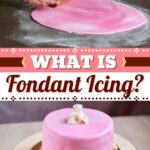What is fondant icing, you ask?
You may have heard this term being tossed around on various cake-decorating shows. Or maybe you’ve seen fondant on cakes at your local bakery.

Well, I’m here to shed some light on this sugary concoction.
Fondant is the superhero of cake decorating. It’s malleable, versatile, and can transform your cake into a work of art.
It’s ideal for crafting intricate designs or creating 3D edible art. #letyourimaginationrunwild
Below you’ll learn everything you need to know about fondant. Including how to make your own!
So, what is fondant icing? Keep reading to find out!

What Is Fondant Icing?
Fondant icing is a sugary paste bakers use to cover cakes, cupcakes, and other treats.
You typically roll it out into thin sheets, then drape it over a cake. Fondant helps to create a smooth surface.
Its consistency is like Play-Doh, so it is fairly easy to work with.
Buttercream icing, though delicious, can be difficult to work with. Especially for creating a smooth finish.
Blanketing your cake with fondant makes it easy to create a seamless exterior.
Fondant also withstands temperature changes better than buttercream, which can be temperamental.
Some bakers claim fondant creates a better blank canvas for decorating.
But wait, there’s more! You can also mold this sugary compound and shape it into many designs.
You can create intricate flowers, delicate lace patterns, and 3D figurines. Who said you couldn’t play with your food?!
Standard fondant doesn’t taste like anything other than sugar. But you can flavor the icing with chocolate, vanilla paste, or extracts.
You can also add food coloring to fondant to create different hues.
Trying to create a cake with a rainbow color scheme or pops of pastels? Fondant can do it all!

What Is Fondant Made Of?
Basic fondant contains water and a lot of sugar. We’re talking cavity-inducing amounts of the sweet stuff.
Most recipes will include a stabilizing ingredient to make the consistency more pliable. Corn syrup or tartar are the most common options.
Glycerine is also a popular addition to maintain a dough-like texture. The correct consistency is the key to creating beautiful 3D art.
While traditional fondants use the aforementioned ingredients, you can make it with marshmallows. I think this is the best-tasting method.
These fluffy white pillows already contain sugar, water, and gelatine. So, you only have to melt them with water and add sugar.

Is Fondant Edible?
Since fondant is mostly sugar and water, it’s definitely edible. That being said, not all fondant is created equal. And some will taste better than others.
You might bite into a cake and find the fondant icing tastes bland. In fact, fondant has a bad reputation for being tasteless.
Many believe that fondant is only useful for decoration.
But you’ll find that fondant icing is actually pretty tasty when it’s flavored well.
You can find variations of the doughy icing that taste like chocolate, vanilla, strawberry, and more!
In many custom cake shops, you can pick the fondant flavor of your choosing. I recommend doing this. You want to get the most out of your sugary sweet treat!
And since it’s loaded with sugar, you may want to brush your teeth afterward.
What Is Poured Fondant?
Poured fondant has a liquid consistency.
So, it is not used for sculpting or rolling. Instead, poured fondant works best as a coating or filling in baked goods.
It creates a lovely glaze when drizzled over a cake or cupcake. You can also dip your baked goods into the icing for an easy, even coating.
Poured fondant does not have the same thickness as rolled fondant. But it still creates a nice seamless layer of icing- a perfect canvas for decorating.
As a bonus, it is much easier to work with.
It’s also relatively easy to make. Follow a regular fondant recipe and add more liquid to thin it out.

How to Make Fondant
Inspired to try making your own fondant?
You only need a few ingredients, patience, and a willingness to get somewhat messy.
You may think fondant icing takes a lot of work. I mean… have you seen an episode of Cake Boss?
Well, you’re not wrong.
It is pretty easy to create a batch of fondant. But it takes a skilled hand to wrap it around a cake without lumps. Or bumps, or tears, or ripples…
Still, you gotta start somewhere. And the result is worth it. Plus, you get to eat your mistakes along the way.
So put on your apron, and let’s get rolling (literally)!
You will need:
1/4 cup cold water
2 tablespoons unflavored gelatin
1/2 cup corn syrup
1 tablespoon glycerine
2 tablespoons shortening (or butter)
8 cups powdered sugar, sifted
- Combine the gelatin with cold water and let it sit until thick.
- Then heat it slowly to dissolve the gelatin.
- Stir in the corn syrup and glycerine until well-mixed, then add the shortening.
- This is also where you should add any flavoring extracts.
- Remove the mixture from the heat and let it cool until it’s lukewarm.
- Place the powdered sugar in a large bowl, making a hole in the center.
- Pour the lukewarm gelatin mixture into the center. Use a wooden spoon to slowly incorporate the batch.
- Add a little of the dry mixture (sugar) to the wet mixture (the gelatin) while kneading it together. It’s a bit like making homemade pasta.
- Keep kneading until the sugar is completely blended in. The fondant will be doughy and sticky on the hands.
- Use your fondant right away or store it in an air-tight container in the fridge. Bring it back to room temperature when you’re ready to use it.
Happy Cake Decorating!











